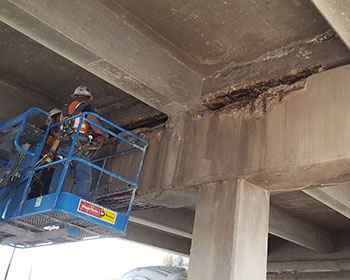

MPC Research Reports |
| Title: | Life-Cycle Cost Implications of Alternative Bridge Inspection Planning |
| Authors: | Abdelrahman Abdallah, Rebecca Atadero, and Mehmet Ozbek |
| University: | Colorado State University |
| Publication Date: | Sep 2023 |
| Report #: | MPC-23-504 |
| Project #: | MPC-533 |
| TRID #: | 01916819 |
| Keywords: | bridges, corrosion, fatigue cracking, inspection, life cycle costing, nondestructive tests, uncertainty |
 Routine bridge inspections in the United States are primarily conducted via visual inspection on a fixed two-year cycle. Although this strategy has generally produced a safe bridge network, a variety of research has been conducted to study enhanced inspection planning processes that could more efficiently use inspection resources, consider the importance and risk associated with structures, and incorporate nondestructive evaluation. This report describes one proposed technique for inspection planning based on the principle that bridge inspections should be conducted when the uncertainty about bridge condition is high and the inspection conducted should collect data that can help reduce the uncertainty about condition. The proposed method is applied to a hypothetical bridge scenario considering both corrosion-induced bridge deck damage and fatigue crack growth in a girder to develop an inspection plan for 20 years. The proposed bridge inspection plan uses variable time periods between inspection and nondestructive evaluation methods. The life-cycle costs of the bridge inspection plan are compared with the life cycle costs of the standard visual inspections on a two-year cycle. Although NDE-based inspections usually cost more than visual inspections, when considered on a life cycle basis, the new inspection plan is cost-effective. The uncertainty-based bridge inspection planning framework is a novel planning approach that offers a multitude of advantages. It provides flexibility to adapt inspection schedules, optimizes resource allocation, mitigates risks, and leads to cost savings. Furthermore, it encourages long-term planning, data-driven decision-making, and adaptive management, ultimately improving safety and environmental considerations. This approach enhances public confidence in bridge infrastructure by demonstrating a commitment to proactive maintenance and resilience. This inspection planning framework helps to conduct bridge inspection only when needed, which will save resources and, with the types of inspection tools, provide the most useful information.
Routine bridge inspections in the United States are primarily conducted via visual inspection on a fixed two-year cycle. Although this strategy has generally produced a safe bridge network, a variety of research has been conducted to study enhanced inspection planning processes that could more efficiently use inspection resources, consider the importance and risk associated with structures, and incorporate nondestructive evaluation. This report describes one proposed technique for inspection planning based on the principle that bridge inspections should be conducted when the uncertainty about bridge condition is high and the inspection conducted should collect data that can help reduce the uncertainty about condition. The proposed method is applied to a hypothetical bridge scenario considering both corrosion-induced bridge deck damage and fatigue crack growth in a girder to develop an inspection plan for 20 years. The proposed bridge inspection plan uses variable time periods between inspection and nondestructive evaluation methods. The life-cycle costs of the bridge inspection plan are compared with the life cycle costs of the standard visual inspections on a two-year cycle. Although NDE-based inspections usually cost more than visual inspections, when considered on a life cycle basis, the new inspection plan is cost-effective. The uncertainty-based bridge inspection planning framework is a novel planning approach that offers a multitude of advantages. It provides flexibility to adapt inspection schedules, optimizes resource allocation, mitigates risks, and leads to cost savings. Furthermore, it encourages long-term planning, data-driven decision-making, and adaptive management, ultimately improving safety and environmental considerations. This approach enhances public confidence in bridge infrastructure by demonstrating a commitment to proactive maintenance and resilience. This inspection planning framework helps to conduct bridge inspection only when needed, which will save resources and, with the types of inspection tools, provide the most useful information.
Abdallah, Abdelrahman, Rebecca Atadero, and Mehmet Ozbek. Life-Cycle Cost Implications of Alternative Bridge Inspection Planning, MPC-23-504. North Dakota State University - Upper Great Plains Transportation Institute, Fargo: Mountain-Plains Consortium, 2023.